Four-wheel driving skills and tips
by Ron and Viv Moon
Australian Shooter July 2002
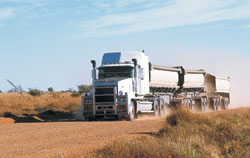
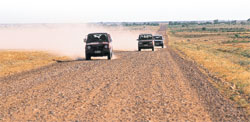
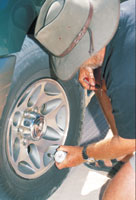
Ron and Viv Moon give the low-down on driving
your 4WD in the rough stuff. Heading off into the rugged mountains after deer or up the beach of a deserted coast to chase a few wild pigs may sound easy and adventurous, but if you don’t know what you are doing with your 4WD, you may not even get to the hunting area. But, whether you are driving on sand or up steep hills there are a few skills and techniques you should know and use to help you get through.
Starting Out on Dirt Roads
One of the great tyrannies of our vast continent is that once we get away from the more settled areas we end up on dirt roads. No matter how good the dirt road is you’re travelling on, it demands more concentration than a bitumen road. Always expect the unexpected.
As it is easy to get out of kilter on gravel or lose control after hitting an unseen wash-away or even a stock grid, keep a good lookout well ahead.
Know what to do in understeer and oversteer situations. It’s easy to lose control on gravelly corners, so approach them with caution. Throttle control is important, so know when to button off or to keep the hammer down.
For part-time 4WD vehicles, don’t be afraid to put your vehicle into 4WD once you are onto even a slightly slippery dirt road or sandy track. That means locking the freewheeling hubs and selecting high ratio 4WD. We’re continually amazed at how many times we’ve come across people who are locking their hubs when they are already bogged or, worse still, don’t even know they have freewheeling hubs. Lock the hubs before you get onto the dirt and leave them locked until you are back on the blacktop near home.
Full-time 4WD vehicles can handle the slippery roads and tracks better than a part-time rig in 2WD, but as soon as the road starts to get a bit softer or boggy, lock the centre diff. Sure, you may get through easily enough in 2WD or without the centre diff locked, but you’re hardly prepared for the rough stuff and your vehicle will exhibit better control in 4WD. If both axles are sharing the load, the vehicle will be doing the work and getting through easier. You don’t get a prize for pushing as far as you can in 2WD.
Make sure you are running the right tyre pressures. If your vehicle is fitted with Passenger (‘P’) or Highway (‘H/T’) type tyres, they will have a maximum pressure on them. Even though it seems quite low, don’t exceed it, as on stony roads they are sure to puncture. In fact, out on the dirt it’s best to get rid of these softies and get some real rubber under your truck - A/T (all terrain) or L/T (light truck) at the very least.
Slow down for oncoming traffic. You’ll save a lot of ‘agro’ for yourself and the other traffic, as well as a windscreen or two. If it’s a road train coming towards you, it’s best to get off the road and let him and his dust cloud pass. They certainly won’t move off the road for you.
Passing someone who is throwing up a huge plume of dust is fraught with danger. Choose your time well and call them up on the CB radio and let them know your intentions. Pick a time when the dust cloud is obscuring the road as little as possible and switch on your lights. Otherwise drop back out of the dust and enjoy the slower pace - it’s the safest thing to do.
Finally, don’t travel too fast. While it’s easy to be tempted by those long flat straights, a heavily laden 4WD is not the vehicle to test your driving skills. If you are towing a trailer or van be doubly cautious.
Sand Driving
Sand can be a real challenge to drive on and no matter where it is, it subjects the vehicle to heavy workloads. The object is to make the driving as easy as possible, while keeping the strain on the vehicle to a minimum.
Tyres play an important part here, with good sand tyres having a relatively large rolling diameter, a wide, smooth, rounded profile and a shallow close tread pattern. Generally, highway type tyres make better sand tyres than aggressive muddies, so what comes as standard on new vehicles are half-reasonable in the sand.
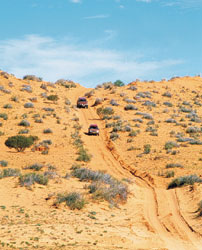
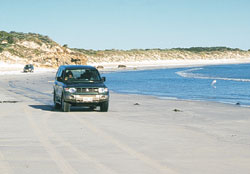
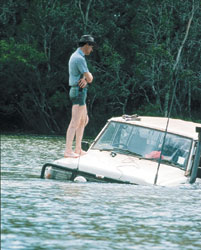
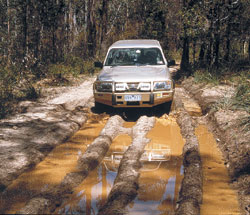
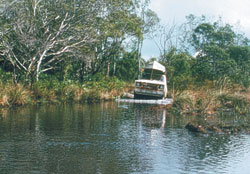 Tyre pressure is the single most important aspect of sand driving, so carry a good tyre pressure gauge with you. Always lower the pressure to about 140kpa or 20psi as a starting point. Of course that will depend on how heavy your vehicle is and the likelihood of sidewall damage. On the soft beaches of Robe in SA, you may find you’ll need to go to 70 to 100kpa (10-12psi) for easy running. While on the twig and rock-strewn sands of the Canning Stock Route, with a fully loaded Cruiser or Patrol, 170kpa or 25psi may be a better compromise.
Tyre pressure is the single most important aspect of sand driving, so carry a good tyre pressure gauge with you. Always lower the pressure to about 140kpa or 20psi as a starting point. Of course that will depend on how heavy your vehicle is and the likelihood of sidewall damage. On the soft beaches of Robe in SA, you may find you’ll need to go to 70 to 100kpa (10-12psi) for easy running. While on the twig and rock-strewn sands of the Canning Stock Route, with a fully loaded Cruiser or Patrol, 170kpa or 25psi may be a better compromise.
Low tyre pressures come with a decrease in control and handling. Keep speeds down to a reasonable pace even when you’re on a good section of track or beach. Sudden turns may roll the partially deflated tyre off the rim, while at the very least, there will be more body roll, caused by the tyre’s sidewalls flexing.
Tackle dunes head on and exercise caution on steep slopes. Do not brake and keep the nose of the vehicle pointing downhill. Don’t go fast, but don’t go so slow that the wheels stop or the vehicle begins to slew sideways. A little acceleration will keep the wheels rolling and the vehicle pointing in the right direction.
Watch your speed as you crest a dune - it may be a lot steeper on the other side. If you are travelling too fast, it is easy to get airborne.
On difficult sand ridges it’s a matter of try and try again, packing down the sand on the same route up the hill. Try different gears and ratios. As you become more experienced you’ll begin to know what your vehicle prefers for a particular circumstance.
Speed and flotation are the keys to success in sand. High ratio 4WD is generally the way to go, unless you’re in the real thick stuff or trying to climb dunes like Big Red out of Birdsville, where low ratio third gear is a good starting point.
Stick to any existing wheel tracks - the vehicle in front will have packed the sand down a little, making it easier for those following.
Avoid sudden changes in direction or acceleration. Coast to a stop and use the brake sparingly. If you need to do a U-turn, the best way on a beach is to gradually work your way up to the high side of the beach and then turn down the slope.
If you become bogged, select low ratio and rock the vehicle backwards and forwards. The idea is to build up a small stretch of hard-packed sand that you can use to accelerate from. Don’t spin the wheels.
A couple of final points: Have your recovery gear handy. You will use it sooner or later. And, once you’re off the beach or on a hard surface, reinflate your tyres. After you’ve been on the beach it’s wise to wash your vehicle down, as soon as possible.
Mud Driving
You’ll find mud, glorious mud, everywhere in Australia and the variety and the form it takes is as variable as the places you’ll find it. The mud holes of the mountains are vastly different to the clay pans of central Australia or the black soil plains of western NSW.
The general H/T type tyre fitted as standard to most new 4WD vehicles will be hopelessly inadequate in these conditions. While BFG Mud Terrains (M/T) are the tyres most others are measured against, there is other rubber, such as Mickey Thompson Baja Claws, the Simex Jungle Trekker or the range of Super Swampers, that really excels in these conditions.
No matter what your truck is wearing, don’t rush in where angels fear to tread. Check the route out first if you are at all doubtful.
Out on the vast western plains when a track has turned to glug because of recent rains, high range 4WD is probably the best. It’s easy to lose control on such surfaces and, while it can be fun doing the odd 360, you need to be aware of any oncoming traffic, nearby trees and narrow gates. Use your brakes sparingly and depend on the gears to help slow you down.
In real heavy going, the main thing is to keep moving. Low second or third are probably the best gears, but it really depends on how deep and sticky the mud is. If you begin to lose traction, move the steering wheel vigorously from side to side to help the shoulder of the tyres to bite and get some grip. Stay out of ruts if possible, as it is easy to get hung up and then you’ll go nowhere.
If you do stop, don’t give up. Try to reverse out and if that fails move the vehicle backwards and forwards, trying to build up a stretch of firmer ground. If you are not digging holes or are high centred you can be a little boisterous with the throttle - a spinning wheel will shed mud from the tyre and possibly give you just enough grip and momentum to keep going. You’ll be surprised at what perseverance can do.
Mud can be hell on brakes and bearings so after playing in it, give everything a good wash down.
No matter how much skill you have or how well your vehicle is set up, sooner or later you’ll get stuck and need some recovery work, but that’s another story.
